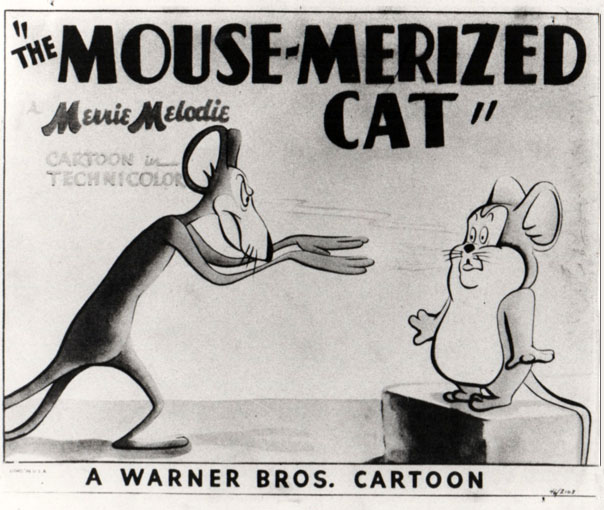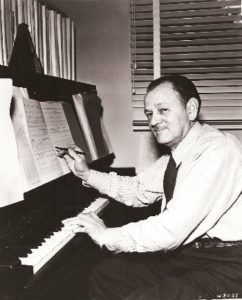
This new set of posts is a bit of an experiment. It contains a wealth of intriguing information, but not as much to make it into a regular series.
 A few years ago, I acquired a dissertation written by music historian/instructor Daniel Goldmark, which evolved into his book Tunes for ‘Toons: Music and the Hollywood Cartoon. Besides Daniel’s astute observations on the importance of classical music and popular songs in animated short cartoons, the document itself contains ASCAP cue sheets from almost every animated theatrical short from Warner Bros. The only exceptions not included in his research are six titles that featured stock music from John Seely’s Capitol Hi-Q library–which resulted from a musicians’ strike in 1958–and side projects such as the Private Snafu and Seaman Hook shorts for the war effort.
A few years ago, I acquired a dissertation written by music historian/instructor Daniel Goldmark, which evolved into his book Tunes for ‘Toons: Music and the Hollywood Cartoon. Besides Daniel’s astute observations on the importance of classical music and popular songs in animated short cartoons, the document itself contains ASCAP cue sheets from almost every animated theatrical short from Warner Bros. The only exceptions not included in his research are six titles that featured stock music from John Seely’s Capitol Hi-Q library–which resulted from a musicians’ strike in 1958–and side projects such as the Private Snafu and Seaman Hook shorts for the war effort.
Many animation buffs are aware of Warner Bros.’ elimination of the main titles from several of their cartoons from 1935 to 1948 under the “Blue Ribbon” banner. This practice excised the credited artists in the films, though that information can be found through easily available copyright entries. Warners also spliced the “Blue Ribbon” titles onto the original negatives when they junked the original main credit sequences. As another casualty, Carl Stalling’s music underneath the main titles was deleted.
In the past decade, a good number of Warner Bros. cartoons previously given the “Blue Ribbon” have had their original main titles re-instated on home video, and others have surfaced from various film collections. As for original titles that have not yet surfaced picture or music element, the ASCAP cue sheets in Daniel Goldmark’s dissertation list each song used in each Warners cartoon, which leads to a big question that can now be answered: just what music did Carl Stalling originally use for these main title sequences?
First, I would like to share three examples of music cues that can be heard today, but no picture element has been available to the public as of this writing.
In the early 1990s, Greg Ford and Hal Willner produced two CD volumes of The Carl Stalling Project, which featured musical excerpts from Stalling’s career at Warners. One of the prominent tracks on the first volume was the score for Chuck Jones’ The Good Egg (1939), which included the original main title cue, “(Ho-dle-ay) Start the Day Right” (Charles Tobias/Al Lewis/Maurice Spitalny), which starts abruptly after the re-issue titles.
Here is a comparison from the Blue Ribbon titles to the original version for you to listen:
Around the same time The Good Egg was released, the studio produced its second gag reel featuring various staffers, intended to be shown at their annual Christmas party. The first gag reel, from 1938, featured a musical underscore from Bob Clampett’s then-upcoming Porky’s Tire Trouble, released in early 1939. The music in the second gag reel was sourced from the orchestration for Tex Avery’s The Early Worm Gets the Bird, released in early 1940. In the opening inter-title of the gag reel, Carl Stalling’s original main title cue for Avery’s film is played in the background. Here is another comparison between the two soundtracks:
The first volume of The Carl Stalling Project contained a medley of soundtracks from the war period (1942-46). One of these included the original main title cue for Bob McKimson’s The Mouse-Merized Cat (1946), a sequel to Frank Tashlin’s Tale of Two Mice, released a year earlier. Several years ago, the main title card for the film–sourced from a 16mm B&W dupe on eBay—was revealed, but the original film elements in color have not. Here is Stalling’s main title cue for the cartoon—a jazzy, dynamic rendition of “Three Blind Mice”.
For next week’s post, I’ll unearth a few music cues from other Warner Bros. cartoons under the “Blue Ribbon” banner, including songs that Carl Stalling used only once during the main credit sequences.
(Thanks to Daniel Goldmark, Andrew Gilmore and Yowp for their help.)



 DEVON BAXTER is a film restoration artist, video editor, and animation researcher/writer currently residing in Pennsylvania. He also hosts a
DEVON BAXTER is a film restoration artist, video editor, and animation researcher/writer currently residing in Pennsylvania. He also hosts a 




















































































Another way to find those lost title card music tracks is to search the SABAM site: https://www.sabam.be/pls/apex/f?p=1050:1:0::NO:::&p_lang=en . Unfortunately they don’t have every LT/MM listed, and some of them are listed as “work unavailable”. Regardless, I was able to ID a few Blue Ribbon title card tracks through the process of elimination.
Worthy experiment! Do continue, please.
I guess that such an idea would never happen but, in the cases where the original scores can be found with visuals missing, it would sure be nice if the artists at Warner Brothers could recreate a new title card, this time giving the animators credit, along with alternate voice talents.
In “THE GOOD EGG”, for example, there are other voices, and I don’t think that Mel Blanc is heard at all in any part of the cartoon. Were the hens’ voices, along with the bawling hen who eventually adopted an abandoned egg, done by Sarah Berner? I still hold out hope that missing elements turn up in these cartoons, because it really adds so much that you can hear the original openings that were apparent when folks saw these films in theaters.
One curious title sequence (and I hope I have this title correct) is “DOUBLE CHASER”, the cartoon in which a frustrated mouse finally confronts the cat, demanding to know why he, the mouse, is chased every day when he attempts to explore outside of his mousehole. My curiosity peaks when I hear the end fanfare, far different from any other LOONEY TUNES or MERRIE MELODIES cartoon and never used again throughout the history of the studio. Oh, and is it possible that “Start the Day Right” was the most oft-used theme throughout the years that Termite Terrace was creating those fantastic theatricals? Bugs Bunny actually hummed it, singing only the words that were the title of the song, in a later cartoon, and the song was featured in one of those inanimate objects come to life cartoons and again in a black and white PORKY PIG cartoon.
I often wished that the CARL STALLING PROJECT series had gone on, because there are so many terrific little seconds long musical moments that definitely need to be part of anyone’s CD library. I even find the pre-Stalling scores quite interesting, sometimes jazzy in their own way. I hope more of these surface, and I look forward to future posts, here, on this subject.
“Oh, and is it possible that “Start the Day Right” was the most oft-used theme throughout the years that Termite Terrace was creating those fantastic theatricals?”
Nah, not even close. It was used only twelve times throughout the filmography: https://www.imdb.com/name/nm2226602/ . Whereas “We’re in the Money” was used well over fifty times.
Only, Kevin W., you’ve got the title wrong: It’s “The Cat’s Tale”, NOT “Double Chaser”. How about the slightly different version of the 1941-1955 Merrie Melodies close theme, starting with “The Wacky Wabbit”, and reprised for the following:
“Tick Tock Tuckered”
“Booby Hatched”
“Peck Up Your Troubles”
“The Merry Old Soul”
“Trap Happy Porky”
and maybe a few or others.
(Though I’m sure the abysmal Bill Lava cues from the almost as abysmal later shorts will be, and should be, excluded as well.BTW With all dues respect to Mr.Goldmark and his research, I’ve looked thru his Toon for Toons book and it seems almost to be a “The of art (only) What’s Opera Doic”, and almost nothing else. He’s rather hard on TV cartoons–very gifted composers worked for the stock libaries and very evocative tunes..and all of the artists and actors came fromtheatrical shorts..but otherwise very great guy.). I also wanna see every title to see what they looked like, esp.1935’s “Flowers for Madame” and 1936’s “The Cat Came Back.” I’ve seen the suppresed “Sunday go to Meetin’ Time” (also 1936)..it has the speedy (not Gonzales!) “That’s all folks'(sic) phrase a la “I Wanna Play House’ and “I love to Singa” also from that year, and probaly the others I mentioned.)
Hard to believe how little studios used to care about their product in the so-called Golden Age. Obviously, Warners felt their old cartoons had enough value to reissue them as Blue Ribbon releases, but to cut the titles off from the original negatives sounds sacrilegious to our modern sensibilities.
The cue for THE GOOD EGG is very epic sounding, in stark contrast to the depressing tone of the short itself.
On the 1938 gag reel, I recall hearing a bit of what sounded like the cue for ROBIN HOOD MAKES GOOD.
I look forward to this series of entries.
You beat me to it, but I’m certain the opening cue to ‘Robin Hood Makes Good’ was used in the gag reel. Unfortunately, I think it has narration over it so a clean version can’t be sourced.
The opening to ‘The Good Egg’ is a prime example of two phenomena. First, it shows how Warners really took a meat cleaver to the shorts with some reissues, chopping off music in mid-cue. It’s really bad with 1930s shorts where the overture often led into the first scene. The infamous ‘Sunday Go To Meetin’ Time’ is another case where I’m glad the original titles have been located, so that the clip that peters out just after the reissue card can finally be heard in full.
Second, it’s an example of how even for what was a rather mediocre cartoon, Stalling could almost always be relied on to give us a really rousing, almost epic overture. This one in particular quickly became one of my favorite bits of music by him, and I hadn’t even seen the actual short at the time I received my copy of ‘The Carl Stalling Project Vol. 1’!
Or in some cases mid sentence. The opening cue of CROSS COUNTRY DETOURS has long held my curiosity. Same for THE CAT CAME BACK.
At least they got better about not cutting off certain parts off in later reissues.
Just checked the first gag reel, and you’re both correct: the original main title cue for ROBIN HOOD MAKES GOOD is, indeed, there. However, as David said, Mel Blanc’s narration and Treg Brown’s “cutting” SFX get in the way…
Random note: As a kid, I thought the Blue Ribbon cards meant the short had in fact won an Oscar or some other award.
Also thought Associated Artists Productions — the outfit that tacked its logos onto Loony Tunes and Popeye shorts for television — was something like a union of the animators and others who actually made the cartoons.
A frame of the original title card of “The Early Worm Gets the Bird” was posted many years ago on this site’s predecessor (https://www.cartoonresearch.com/warner.html), so a pretty good reconstruction could someday be put together. I assume it had the usual rainbow rings of the ’39-’40 releases, the only element still unknown is the original prod. number.
I do hope someday we’ll see a high resolution scan of those tantalizing Avery frames.
Is there a way we can get “The Good Egg”s original titles?
It’s inspiring to see how Daniel was able to turn his dissertation into a book that has been so well-received.